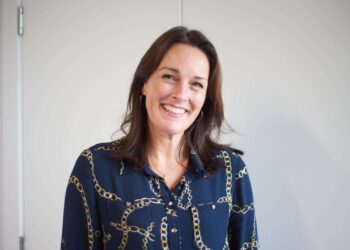Hitachi Vantara is breaking new ground on supply chain sustainability and hardware reuse at its European Distribution Centre (EDC) and Centre of Excellence (CoE).
IT Channel Oxygen caught up with the storage vendor’s director of sustainability operations, EDC, Maarten de Groot and CoE manager Bart Gugelot to discover how the channel can tap into what it now offers.
Hi both. What is Hitachi Vantara’s ‘EDC,’ and what do you provide partners via your Centre of Excellence as part of this?
Bart: The EDC is our European Distribution Centre. Essentially, it’s the supply chain for Hitachi Vantara in EMEA.
What you’re seeing in the video above is the geothermal installation that heats and cools the buildings. It’s also showing that there are 6,200 solar panels on the roof that supply approximately one-third of our annual power needs. Additionally, we’ve equipped our trucks with solar panels and installed 22 electric car charging stations, all powered by solar energy.
Maarten: The EDC covers distribution within EMEA. It distributes our customer orders and supports our spare part orders within the region.
We also have a distribution centre (DC) in China, one in Singapore that covers all the Asian countries along with Australia and New Zealand, one in Oklahoma that is connected to one of our factories, and one in Japan. All five DCs are operationally the same. Replication and consistency are very important so that we can always support our customers and distribute our products from each DC to all regions in the same way.
Bart: We started the CoE here in the EDC to be in close proximity to product innovation. The CoE is part of the technical pre-sales organisation, and in short, we are the showroom for the products and solutions that Hitachi Vantara offers partners and customers. As technical experts, we provide assistance to speed up the sales cycle, showcase what we have to offer, and help to find solutions for the challenges customers might have.
The CoE has grown substantially over the last year. We now offer specific services to educate our partner community on our solutions, as well as data discovery services to obtain more insight into customers’ environments for more tailer-made solution selling. This includes sustainability efforts to ensure our products and solutions are meeting customers’ environmental goals. It’s about collaboration, especially with our partners.
What differentiates you from the rest of the market?

Maarten: I mentioned that all our DCs operate in the same way. They are ISO certified – 9001 for quality management, ISO14001 for our environmental systems, and ISO45001 for health and safety management. However, the DC in Japan currently has ISO 9001 and ISO 14001, and we’re actively working towards achieving ISO45001 certification.
In Europe and North America, we deliver directly to our end customers using our own truck fleets. Currently, we cannot use electric trucks until the charging infrastructure is more consistent. As an interim solution, we have installed solar panels on top of our trucks. The energy generated by the solar panels is stored on batteries in the truck, which then powers all the electric equipment in the truck. This solution saves fuel and reduces CO2.
The option for electric trucks will come very soon, so we are monitoring this very closely and will switch to them as soon as it is possible to do so.
Another thing that sets us apart is that by using our own truck fleets, we can promote the delivery of unpacked racks to our customers. By using transport racks to move the equipment into the customers’ data centres, we’ve been able to use no packing material in some instances. We simply roll these transport racks into the data centre, shift the equipment into the customer’s rack, and take back returns in the same transport rack.
This approach is unique. When I’m in the CoE and telling customers about our fantastic building and its sustainability credentials, I also inform them about our practices within the supply chain.
In September, your VSP One offering was certified under the US EPA’s ENERGY STAR® programme, adding to sustainability accolades you’ve recently received from the likes of EcoVadis. Why is this one particularly significant?
Bart: This one really hits home because these new ENERGY STAR ratings show that Hitachi Vantara is the most energy efficient of all the storage vendors. Given storage arrays are huge energy consumers in data centres, that speaks volumes.
Reducing Co2 emissions is now a boardroom topic. Is there any way your partners can help an end user predict the Co2 usage of an array they are considering buying?

Bart: Hitachi Vantara provides several tools to partners and customers that estimate the CO2 output for their equipment. All these tools are available through our partner portal. The CO2 Estimator tool has been designed to help our partners drive a consultative discovery session by quantifying their customers’ and prospects’ potential CO2 emissions saving.
We also have the Power and Weight Calculator, which allows users to virtually build the solution via a web-based tool. This calculator provides insight to the power consumption, floor space requirements and even the cost of ownership related to these factors. We also offer a data discovery service in the CoE that evaluates the infrastructure used by the customer, including the cost of ownership using metrics like industry standards for power consumption, I/O profiles, and maintenance costs. This evaluation allows us to provide a detailed overview to the customer on the benefits of replacing aging hardware with new HV solutions, which use less power and reduce overall CO2 emissions.
What’s your reuse strategy?
Maarten: When we sell equipment to customers, we get any returned or used equipment back and always check, validate, and test it. Our planning department then determines what can be reused.
The first option is to reuse the product in its entirety and resell it again with a full warranty, but that’s only for newer or current equipment. When it’s older, we assess if we can reuse it internally, for instance, within our labs.
Before we decide to scrap older equipment, we receive guidelines from our planning department on the standards these components must meet to be used as spare parts. So, we test the hardware, disassemble the products and transfer them to our spare parts department so nothing gets wasted.
When a product or spare part is not useable at all, or it’s defective, we put it in the recycle stream. In Europe, we work with a recycling partner who takes all our e-waste back to their facility. We ship several full truckloads to them each month. We receive a detailed monthly report from the recycler, outlining what was received from us and what has been shredded and converted into raw materials such as aluminium, gold, lead, and plastics.
What % of an array is typically recycled?
Maarten: For a complete storage system, almost 100%. The overall percentage of what we can reuse as raw material is 99.9%, and only 0.01% goes to landfill.

What are Hitachi Vantara’s goals for further helping people achieve their net zeros goals, as it relates to hardware reuse or reducing hardware waste?
Maarten: Hitachi Vantara is in the process of setting ambitious goals around emissions management, and what I’ve learned is that you can only reach those types of aggressive goals by looking at your whole value chain. We are all interconnected and need all our partners – from our suppliers, distributors, resellers to our customers – to help us meet these types of goals. If any part of the value chain falls short, it creates a challenge for everyone.
Bart: That’s a nice segway back into why the CoE is located in the EDC.
To achieve some of these goals, we need to make showcasing our products as easy as possible. Previously, if a customer wanted a demo or proof of value system in their own data centre, for instance in the UK, they would need to order and physically transport that equipment. Now, within the CoE, we offer the opportunity to remotely access that type of fully built demonstration and PoV without it leaving the EDC. This means the partner or customer doesn’t need to incur the travel and installation cost from both a resource and sustainability perspective.
Customers and partners who visit the EDC are always impressed with our story and the added flexibility to not only talk about supply chain but also showcase our products and solutions.
This article was produced in association with Hitachi Vantara and is classified as partner content. What is partner content? See more here.
















